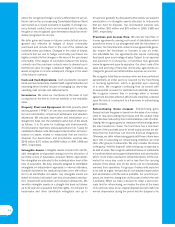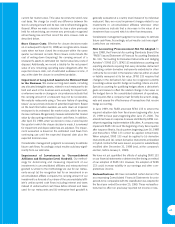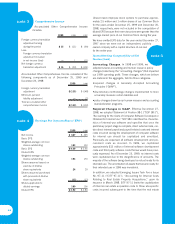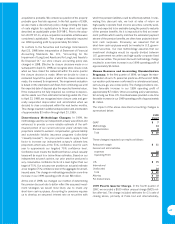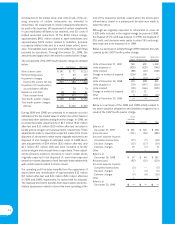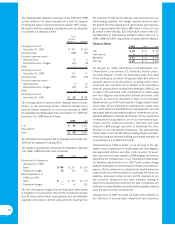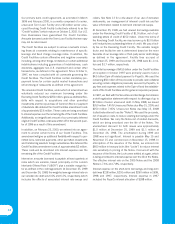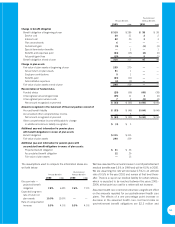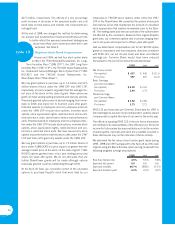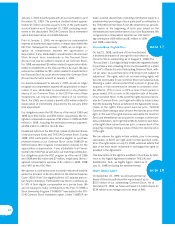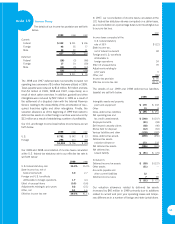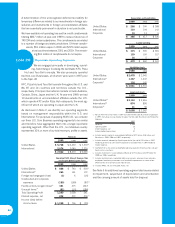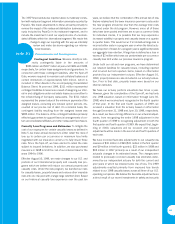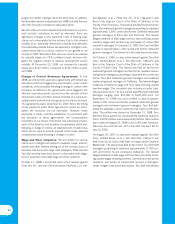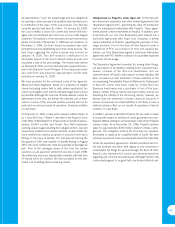Pizza Hut 1999 Annual Report Download - page 55
Download and view the complete annual report
Please find page 55 of the 1999 Pizza Hut annual report below. You can navigate through the pages in the report by either clicking on the pages listed below, or by using the keyword search tool below to find specific information within the annual report.
53
The annual maturities of long-term debt through 2004 and
thereafter, excluding capital lease obligations, are 2000 –
$37 million; 2001 – $3 million; 2002 – $1.7 billion;
2003 – $.7 million; 2004 – $352 million and
$252 million thereafter.
Leases
We have non-cancelable commitments under both
capital and long-term operating leases, primarily for
our restaurants. Capital and operating lease commitments
expire at various dates through 2087 and, in many cases, pro-
vide for rent escalations and renewal options. Most leases
require us to pay related executory costs, which include prop-
erty taxes, maintenance and insurance.
Future minimum commitments and sublease receivables
under non-cancelable leases are set forth below:
Commitments Sublease Receivables
Direct
Capital Operating Financing Operating
2000 $ 17 $ 190 $ 2 $ 13
2001 16 160 2 12
2002 15 142 2 10
2003 15 123 1 9
2004 13 109 1 7
Thereafter 112 617 11 41
$ 188 $ 1,341 $ 19 $ 92
At year-end 1999, the present value of minimum payments
under capital leases was $97 million, after deducting $91 mil-
lion representing imputed interest.
The details of rental expense and income are set forth below:
1999 1998 1997
Rental expense
Minimum $ 263 $ 308 $ 341
Contingent 28 25 30
$ 291 $ 333 $ 371
Minimum rental income $8 $18 $19
Contingent rentals are based on sales levels in excess
of stipulated amounts contained in the lease
agreements.
Financial Instruments
Derivative Instruments. Our policy prohibits
the use of derivative instruments for trading pur-
poses, and we have procedures in place to monitor and
control their use. Our use of derivative instruments has
included interest rate swaps, collars and forward rate agree-
ments. In addition, we utilize on a limited basis foreign currency
forward contracts and commodity futures contracts. Our inter-
est rate and foreign currency derivative contracts are entered
into with financial institutions and our commodity futures con-
tracts are traded on national exchanges.
We enter into interest rate swaps, collars, and forward rate
agreements with the objective of reducing our exposure to
interest rate risk. We entered into interest rate swap and for-
ward rate agreements to convert a portion of our variable rate
bank debt to fixed rate. Reset dates and the floating rate
indices on the swaps and forward rate agreements match
those of the underlying bank debt. Accordingly, any market
risk or opportunity associated with the swaps and forward rate
agreements is offset by the opposite market impact on the
related debt. At December 25, 1999 and December 26, 1998,
we had outstanding interest rate swaps with notional amounts
of $800 million and $1.2 billion, respectively. Under the con-
tracts, we agree with other parties to exchange, at specified
intervals, the difference between variable rate and fixed rate
amounts calculated on a notional principal amount. At both
December 25, 1999 and December 26, 1998, our average
pay rate was 5.9%. Our payables under the related swaps
aggregated $0.4 million and $1.6 million at December 25,
1999 and December 26, 1998, respectively. The swaps
mature at various dates through 2001.
During 1999 and 1998, we entered into interest rate collars to
reduce interest rate sensitivity on a portion of our variable rate
bank debt. Interest rate collars effectively lock in a range of
interest rates by establishing a cap and floor. Reset dates and
the floating index on the collars match those of the underlying
bank debt. If interest rates remain within the collared cap and
floor, no payments are made. If rates rise above the cap level,
we receive a payment. If rates fall below the floor level, we
make a payment. At December 25, 1999, we did not have any
outstanding interest rate collars. At December 26, 1998, we
had outstanding interest rate collars of $700 million, and our
average pay rate was 5.4%. Under the contracts, we agreed
with other parties to exchange, as required, the difference
between the effective LIBOR rate and the cap or floor rate if the
effective LIBOR rates fall outside the collared range.
We enter into foreign currency exchange contracts with the
objective of reducing our exposure to earnings and cash flow
volatility associated with foreign currency fluctuations. In 1999,
we entered into forward contracts to hedge our exposure
related to certain foreign currency receivables. The notional
amount and maturity dates of the contracts match those of the
underlying receivables. Accordingly, any market risk or oppor-
tunity associated with these contracts is offset by the opposite
market impact on the related receivables.
Our credit risk from the interest rate swap, collar and forward
rate agreements and foreign exchange contracts is dependent
both on the movement in interest and currency rates and
possibility of non-payment by counterparties. We mitigate credit
risk by entering into these agreements with high-quality
note 13
note 12



